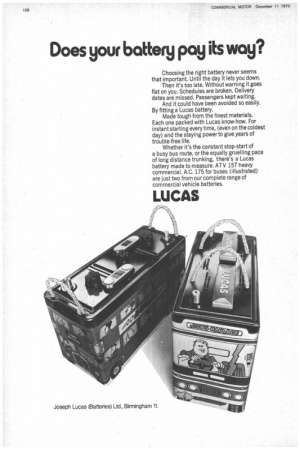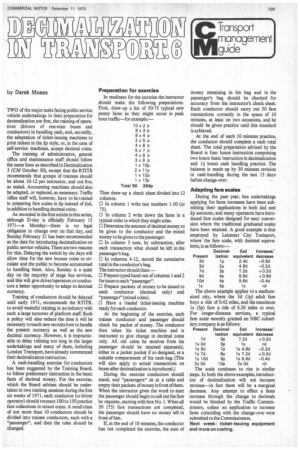Does your battery pay its way?
Page 110

Page 111

If you've noticed an error in this article please click here to report it so we can fix it.
Choosing the right battery never seems that important. Until the day it lets you down.
Then it's too late. Without warning it goes flat on you. Schedules are broken. Delivery dates are missed. Passengers kept waiting.
And it could have been avoided so easily. By fitting a Lucas battery.
Made tough from the finest materials. Each one packed with Lucas know-how. For instant starting every time, (even on the coldest day) and the staying power to give years of trouble-free life.
Whether it's the constant stop-start of a busy bus route, or the equally gruelling pace of long distance trunking, there's a Lucas battery made to measure. ATV 15T heavy commercial. A.C. 175 for buses (illustrated) are just two from our complete range of commercial vehicle batteries. TWO of the major tasks facing public service vehicle undertakings in their preparation for decimalization are first, the training of operatives (drivers of one-man buses and conductors) in handling cash, and, secondly, the adaptation of ticket-issuing machines to print tickets in the Lp style, or, in the case of self-service machines, accept decimal coins.
The training of administrative, general office and maintenance staff should follow the same lines as described in Decimalization 5 (CM October 30), except that the RTITB recommends that groups of trainees should be about 10-12 per instructor, and not five, as stated. Accounting machines should also be adapted, or replaced, as necessary. Traffic office staff will, however, have to be trained in preparing fare scales in fp instead of Lsd, in addition to handling decimal coins.
As recorded in the first article in this series, although D-day is officially February 15 1971—a Monday—there is no legal obligation to change over on that day. and Sunday February 21 has been recommended as the date for introducing decimalization on public service vehicles. There are two reasons for this. Delaying the switch by six days will • allow time for the new bronze coins to circulate and the public to become accustomed to handling them. Also, Sunday is a quiet day on the majority of stage bus services, and this will give driver/operators or conductors a better opportunity to adapt to decimal currency.
Training of conductors should be delayed until early 1971, recommends the RTITB, to avoid wasteful training in an industry with such a large turnover of platform staff. Such a policy will also reduce the time it will be necessary to teach new recruits how to handle the present currency as well as the new decimal currency. However, it is impracticable to delay training too long in the larger undertakings and many of them, including London Transport, have already commenced their decimalization instruction.
A cash-handling exercise for conductors has been suggested by the Training Board. to follow preliminary instruction in the basic facts of decimal money. For the exercise, which the Board advises should be undertaken in two training sessions during the first six weeks of 1971, each conductor (or driver operator) should transact 100 to 150 practice fare collections in mixed coins, A small class of not more than 10 conductors should be divided into trainee conductors, each with a "passenger", and then the roles should be changed. In readiness for the exercise the instructor should make the following preparations. First, draw-up a list of 50-75 typical new penny fares as they might occur in peak hour traffic—for example:—
Then draw-up a check sheet divided into 12 columns.
O In column 1 write test numbers 1-50 (or 75).
0 In column 2 write down the fares in a typical order in which they might arise. 0 Determine the amount of decimal money to be given to the conductor and the mixed money to be given to the passenger.
O In column 3 note, by subtraction, after each transaction what should be left in the passenger's bag.
O In columns 4-12, record the cumulative total in the conductor's bag. The instructor should then:0 Prepare typed hand-out of columns 1 and 2 for issue to each "passenger".
O Prepare packets of money to be issued to each conductor (decimal only) and "passenger— (mixed coins).
O Have a loaded ticket-issuing machine ready for each conductor.
At the beginning of the exercise, each trainee conductor and passenger should check his packet of money. The conductor then takes his ticket machine and is instructed to give change in decimal coins only. All old coins he receives from his passenger should be retained separately, either in a jacket pocket if so designed, or a suitable compartment of his cash bag. (This will also apply to actual transactions on buses after decimalization is introduced.) During the exercise conductors should stand, and "passengers" sit at a table and empty their packets of money in front of them. When the instructor gives the word to start the passenger should begin to call out the fare he requires, starting with fare No. 1. When all 50 (75) fare transactions are completed, the passenger should have no money left in front of him.
If, at the end of 10 minutes, the conductor has not completed the exercise, the sum of money remaining in his bag and in the passenger's bag should be checked for accuracy from the instructor's check sheet. Each conductor should carry out 50 fare transactions correctly in the space of 10 minutes, at least on two occasions, and he should be given practice until this standard is achieved.
At the end of each 10 minutes practice, the conductor should complete a cash total sheet. The total preparation advised by the Board is four hours instruction comprising two hours basic instruction in decimali7ation and 1+ hours cash handling practice. The balance is made up by 30 minutes revision in cash-handling during the last 15 days before change-over.
Adapting fare scales
During the past year, bus undertakings applying for fares increases have been submitting their applications in both isd and Lp amounts, and many operators have introduced fare scales designed for easy conversion where the traditional graduated scales have been retained. A good example is that employed by Leicester City Transport, where the fare scale, with decimal equivalents, is as follows:—
The above example applies to a mediumsized city, where the 3d (1p) adult fare buys a ride of 0.42 miles, and the maximum Is (5p) fare a ride of 6.30 miles or over. For longer-distance services, a typical fare scale recently granted an NBC subsidiary company is as follows: The scale continues to rise in similar steps. In both the above examples, introduction of decimalization will not increase revenue—in fact there will be a marginal decrease. Any attempt to effect a fares increase through the change to decimals would be blocked by the Traffic Commissioners, unless an application to increase fares coinciding with the change-over were submitted to the Commissioners.
Next week: ticket-issuing equipment and more on costing.






























































































































































